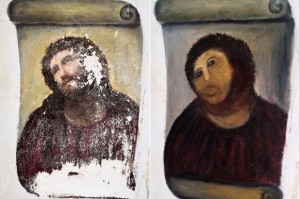I love seeing my friend’s artwork which they post online. Pen and ink drawings, water colours, quilting, landscape art – I’ve got some very talented friends. Back in high school I took some art classes and it soon became apparent to me that the difference between good artwork and great artwork is the subtleties of colour and the shading, the gentle nuances that plays with light and the almost imperceptible dappling of contrasts that people look past in seeing the whole. It is these features that allow your mind to think you are seeing something which isn’t actually just a flat piece of paper with lines and colour. The artist knows how to draw your attention to what they want you to focus on. The empty space is as important as the space that is filled. The background doesn’t just sit there, it leads the eye. And there is a feel to art, a mysterious sense of ethos that is communicated to the person looking that can move them.
I’ve read how Bill Murray was about to take his life when a picture at the Art Institute of Chicago saved his life. It was the 19th-century French realist painter Jules Breton, who depicted a young peasant woman working in a field at sunrise called The Song of the Lark. Somehow that picture gave Him hope and changed the course of his life.
It was a moving encounter with a picture entitled Ecco Home, by Domenico Feti, with the inscription below “this have I suffered for you; now what will you do for me?” that moved a young Count Zinzendorf to commit his life to service for Christ and helped to launch the prelude to the modern missionary movement.
The power and the beauty of art all hangs tentatively on those subtleties, shades and nuances.
God is an artist. For many this a beautiful realization. We love how he paints sunsets with purple hues. We feel the playful joy of the fall leaves changed colours, or the haunting, reflective mood that is set by shadows and light on cresting snow drifts. But apart from nature we sometime forget these subtleties of God’s hand. Some people simply want a black and white moral code. They prefer a Bible that is absolutely literal and denies the poetic nature of the psalms or the figurative symbolism of apocalyptic writings.
“In 2012, an amateur art restorer in the small village of Borja, Spain, turned her attention to a fresco of Jesus Christ called “Ecce Homo” (“Behold the Man”). Alas, Cecilia Giménez’s “fix” rendered the face of Jesus — painted in 1930 by Elías García Martínez — wholly unrecognizable. Ecce Homo 2.0 became a global laughingstock, compared to a blurry potato and a monkey.” – so reports this article in the New York Post. So it is with many modern “interpreters” of the Bible.

I find that sometimes critics of the Bible, fail to catch the nuances that are often present and often sketch a crude, unflattering and misrepresentation of what God is actually communicating. I find other, so called scholars, who want all shade and smudges with no fine, but firm, lines to help distinguish the foreground from the background and blur its message so that its core truth is all but whitewashed.
The Bible is the kind of book that a small child can read to understand, with epic stories of heroes. But it is also the kind of book that a grown adult can stare at with ever increasing intensity and find that the author reaches out through the pages and communicates great truth which moves their heart. It is the kind of writing which intellectuals can scrutinize and dissect and find deeper complexity and wonder as they analyze its composition. That does not make the Bible a bedtime story book, a love letter or a textbook. It is all this and so much more. And as such, the next time you read it and think “I don’t get it?” or “Is that all?” remember that it was written by an artist, look more deeply for the subtleties, shades and nuances.
